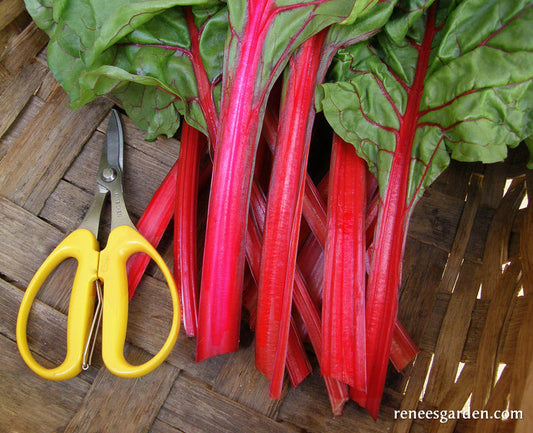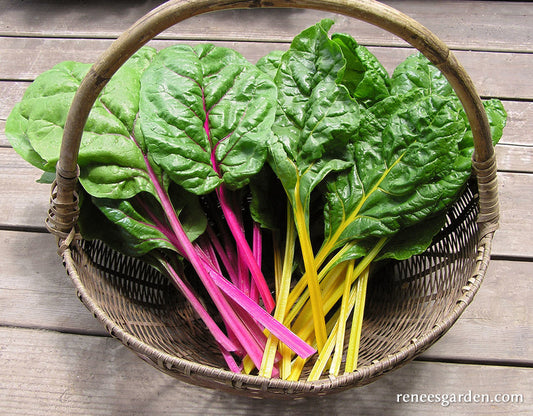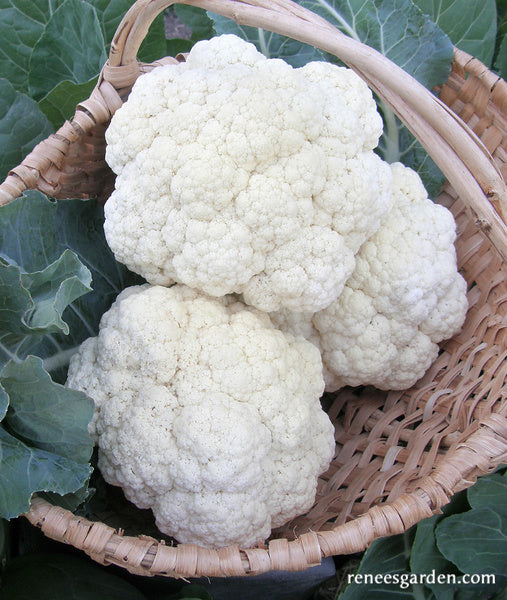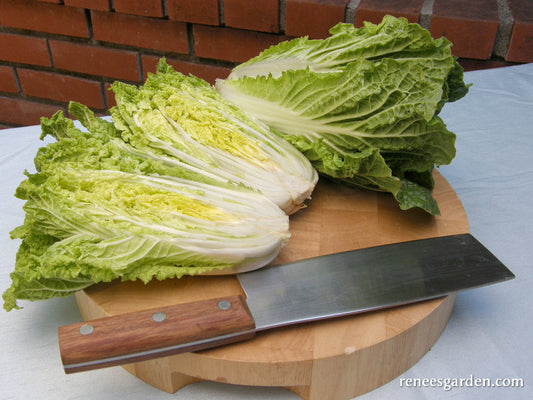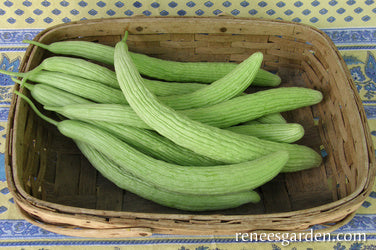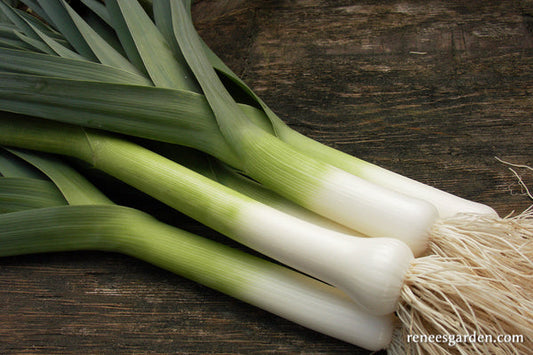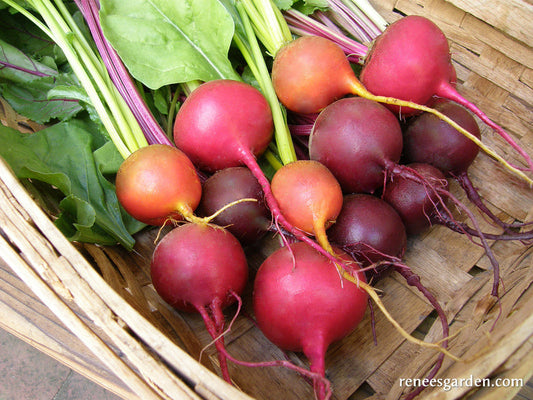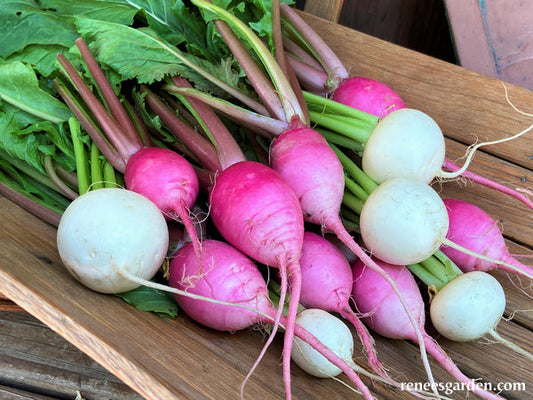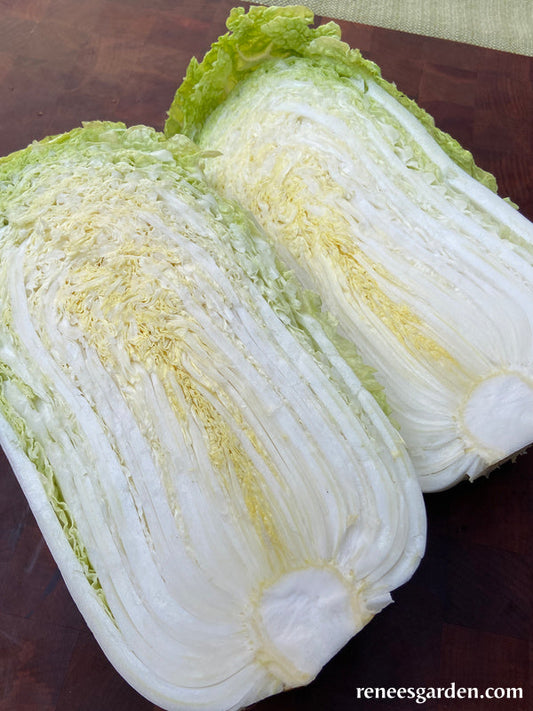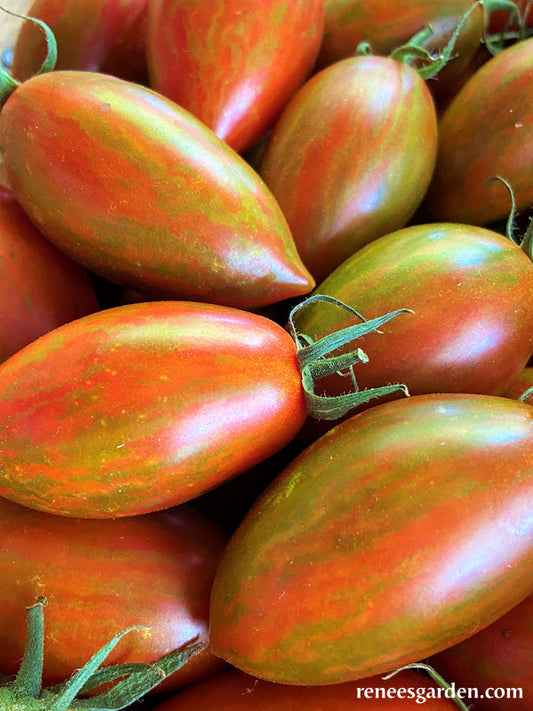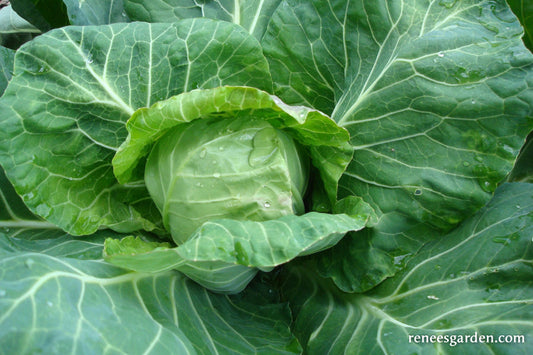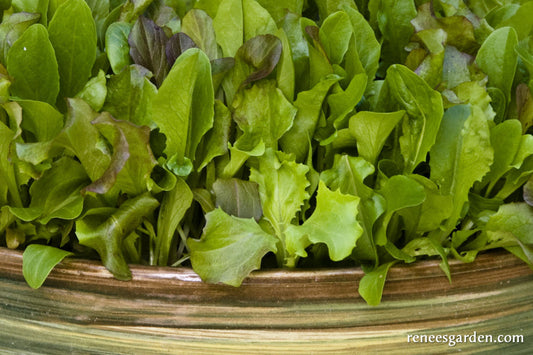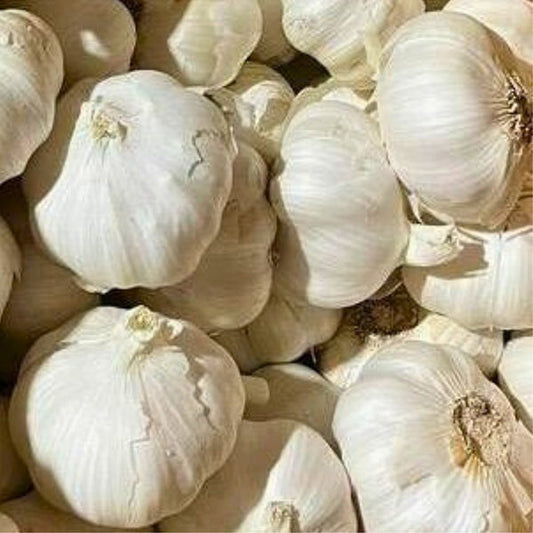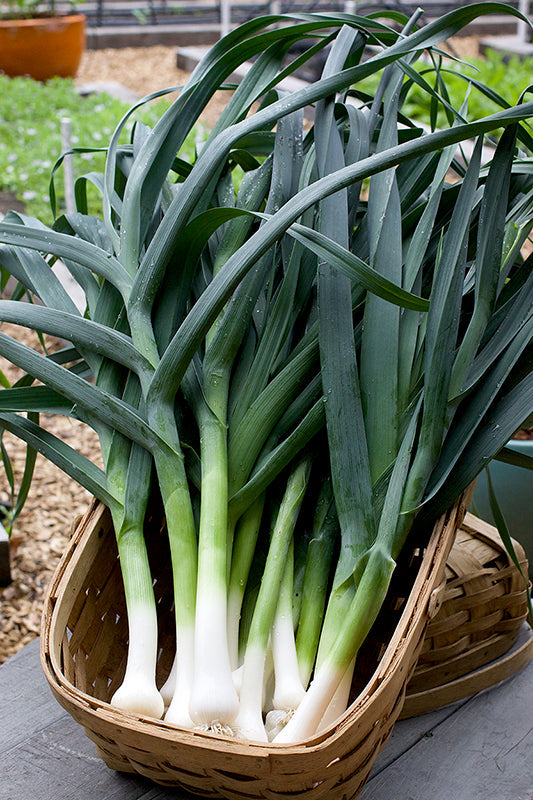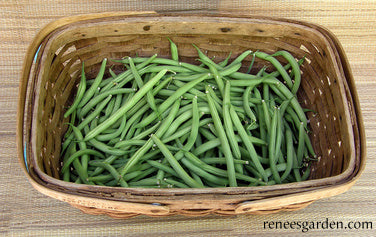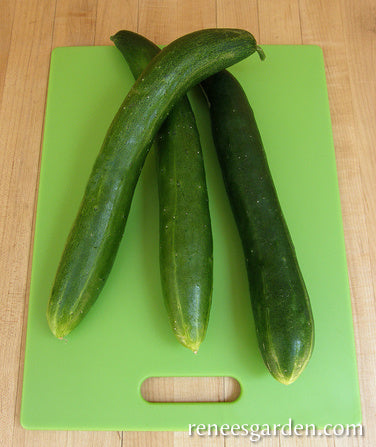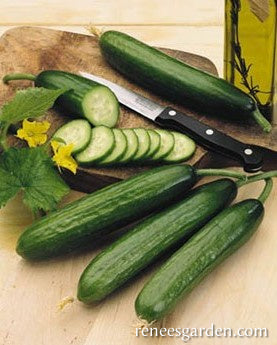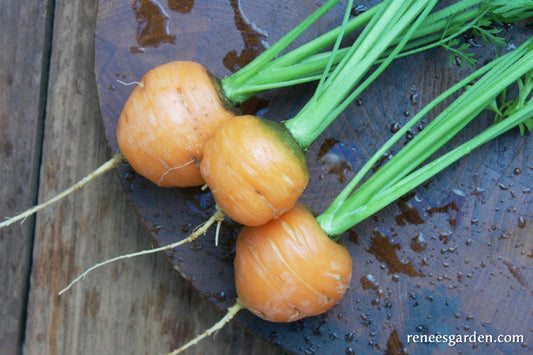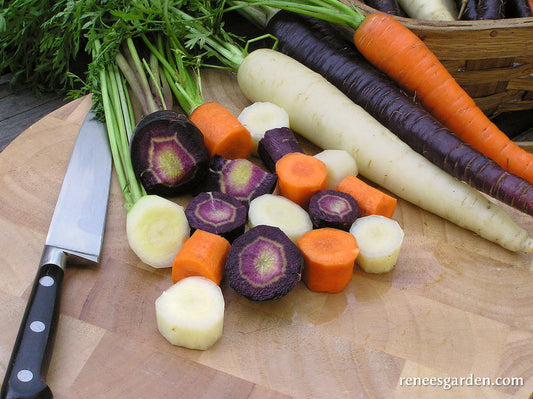Vegetables
Set The Table From Your Garden
-
Gourmet Ruby Chard Scarlet Charlotte
START SEEDS OUTDOORS
In early spring when danger of hard frost is over, sow seeds in well-worked, fertile soil in full sun. Sow seeds 1/2 inch deep and 2 inches apart in rows 10 inches apart. Firm soil well over these irregularly shaped seeds to ensure good germination. If first sowing germinates unevenly, plant more seed in the rows as seedlings catch up quickly. Thin when seedlings are large enough to handle, using thinnings as early greens. Final spacing should be 12 to 18 inches apart.
GROWING NOTES
Chard grows well in a wide range of conditions and can take some frost. In mild winter areas, it can be grown year-round. Thin seedlings well so the large 2 foot tall, vase-shaped plants have room to mature.
HARVEST AND USE
Begin harvesting when plants are well established and have 6 to 8 stalks. Both the crunchy succulent stalks and leaves make great eating. Chop and sauté chard with garlic and olive oil or pair with sautéed mushrooms and onions. Try steamed and topped with a sprinkle of vinegar or fresh lemon juice. Use like spinach in lasagna or minestrone soup.
Regular price $2.99Sale price $2.99Unit price / per -
Rainbow Chard Neon Glow
START SEEDS INDOORS
In early spring, when danger of frost is over, sow seeds in well-worked, fertile soil in full sun. Sow seeds 1/2 inch deep and 2 inches apart in rows 10 inches apart, or broadcast thinly for bed planting. Firm soil well over these irregularly shaped seeds to ensure good germination. If first sowing germinates unevenly, plant more seed as seedlings catch up quickly. When large enough to handle, thin seedlings to final spacing of 8 to 10 inches apart so these large plants have room to grow and mature. Transplant extras or enjoy young thinnings as early greens and salads.
GROWING NOTES
Chard grows well in a wide range of conditions and can take some light frost. In mild winter areas, it can be grown year round. Give seedlings enough room, because chard grows into large vase-shaped plants 2 feet tall.
HARVEST AND USE
Begin harvesting when plants are well established and have at least 6 to 8 leaves. Both stalks and leaves make great eating. Chop and steam or sauté with garlic and olive oil. Use like spinach in lasagna or minestrone soup. Try tasty chard leaves stuffed and poached in broth with a dash of olive oil and fresh lemon.
Regular price $3.39Sale price $3.39Unit price / per -

 Sold out
Sold outUmatilla Russet
NEW THIS SEASON! This fine Russet potato, named for the Native American Umatilla tribe, was developed 25 years ago by the Agricultural Experiment Stations of Idaho, Washington and Oregon. This variety reliably produces big, oval tubers with lightly russeted golden skin, shallow eyes and fine-grained white flesh. They are perfect for making delicious thick-cut oven fries or terrific baked potatoes with temptingly fluffy interiors – the best kind of nourishing comfort food! Heavy for their size, Umatilla tubers grate easily for making delectable potato pancakes or hashbrowns.
Umatilla is also more productive than other Russet varieties, reliably producing bumper crops of good-sized, uniform tubers on strong growing plants. They also store well for a long season of eating pleasure.
Late season: 95-125 days / Type: Indeterminate
1 lb. bag (plants a 10 foot row)
Mix and match your own potato patch:
Save 10% when you buy any 3 varieties or more!
Discount taken at checkout.NOTIFY ME WHEN AVAILABLERegular price $19.95Sale price $19.95Unit price / perSold out -

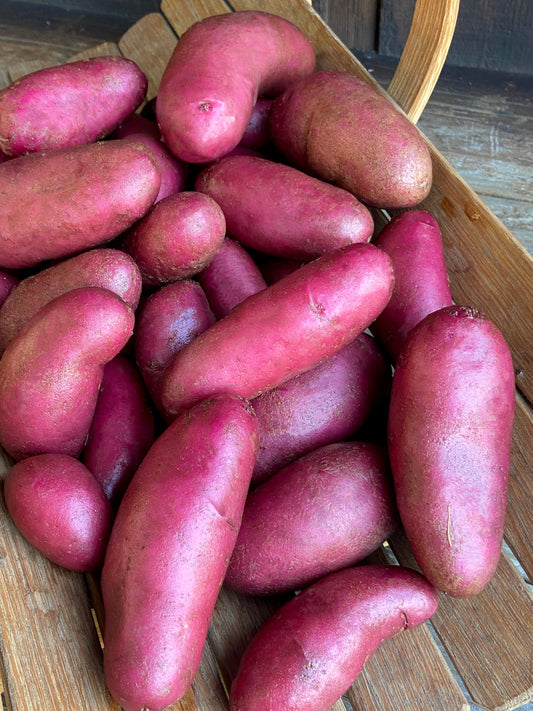 Sold out
Sold outAmarosa Fingerling
NEW THIS SEASON! These unique fingerling potatoes have smooth, ruby colored thin skins and marbled rose and pink flesh that keeps its pretty coloration when cooked. Amarosa’s interior texture is creamy smooth and nutty tasting, and they don’t fall apart when you cook them. Enjoy them in colorful potato salads, cooked and cut up into small cubes as a tasty accent for green salads, or simply steam and serve with butter and chopped parsley or chives.
Because of their rich interior color, these slender oblong fingerlings are particularly high in antioxidants. Amarosa fingerlings have demonstrated good scab resistance, moderate keeping ability and produce well across different climate zones. Their firm texture, excellent flavor and vivid color – both inside and out – makes them a wonderful home garden choice. If you have an air fryer – think pink potato chips!
Midseason: 85-95 days / Type: Determinate
1 lb. bag (plants a 10 foot row)
Mix and match your own potato patch:
Save 10% when you buy any 3 varieties or more!
Discount taken at checkout.NOTIFY ME WHEN AVAILABLERegular price $19.95Sale price $19.95Unit price / perSold out -
Cauliflower Amazing Taste
BEST TO START INDOORS
Start seeds 4 to 5 weeks before last expected frost. Sow 1 inch apart in a container of seed starting mix and cover 1/4 inch deep. Keep moist but not soggy. Provide a strong light source until seedlings are ready to plant out. When seedlings have 2 to 3 sets of true leaves, acclimate to outdoor conditions and transplant 12 to 18 inches apart into rich, well-drained soil in full sun. In mild winter climates, sow again in mid-summer for a fall crop.
TO START OUTDOORS
About 4 to 6 weeks before last frost, sow groups of 2 to 3 seeds 12 to 18 inches apart and 1/4 inch deep in well-drained, fertile soil in full sun. Tend carefully and thin to 1 strong seedling per group when several inches tall. Proper thinning is critical for successful heads.
GROWING NOTES
Fertilize growing cauliflower every three weeks and keep well weeded and watered to provide the rapid growth cauliflower requires to form good heads. Amazing Taste’s outer wrapper leaves help shield its heads from sun discoloration. Harvest the pure white heads promptly when fully filled out. Nontoxic “BT” (Bacillus thuringiensis) products work well to control caterpillar pests.
HARVEST AND USE
Enjoy Amazing in salads, with dips, or break into florets and lightly steam or toss with olive oil and roast till tender. Note: Cauliflower will cook more quickly when fresh from the garden.
Regular price $4.69Sale price $4.69Unit price / per -
Baby Napa Cabbage Little Jade
TO START INDOORS
Start seeds 4 to 5 weeks before last spring frost. Sow 1 inch apart in seed starting mix, cover 1/4 inch deep and keep evenly moist. Provide a strong light source until seedlings are ready to plant out. When several inches tall, transplant seedlings 10 inches apart into rich soil in full sun, after gradually acclimating to outdoor conditions.
TO START DIRECTLY OUTDOORS
When all danger of frost is over, plant in well-worked, fertile soil in full sun. Sow clusters of 2 to 3 seeds 10 inches apart in rows spaced 1 foot apart. When seedlings are several inches tall, thin to 1 strong plant every 10 inches. In mild winter climates, sow seeds again at midsummer for a fall crop.
GROWING NOTES
Baby Napa cabbage needs full sun and rich, well-drained soil to produce firm, sweet heads. To avoid stunting growth, don’t let seedlings get crowded before thinning or transplanting. Keep weeded and evenly watered. Feed monthly with fish emulsion or an all-purpose fertilizer; strongly growing, healthy plants resist pests much more successfully. Use non-toxic B.T. (Bacillus thuringiensis) for caterpillar pests. Floating row covers provide a good barrier method to exclude pests. Remove covers when heads begin to form.
HARVEST AND USE
Cut the 8 to10 inch tall vase-shaped heads when they are very solid and well-formed and about 4 to 6 inches wide.
Regular price $4.39Sale price $4.39Unit price / per -
Heirloom Cucumbers Sweet Armenian
START SEEDS OUTDOORS
Plant heat-loving cucumbers only when weather is warm and night temperatures stay above 50° F (10° C). Amend soil well with age manure or compost. Sow groups of 2 to 3 seeds, 1 inch deep and 18 inches apart. When the baby seedlings are 2 inches long, thin out extras, leaving one strong seedling per group.
After thinning, provide a 3 to 5 foot strong vertical support or individual tomato cage around each seedling and train the vines up the supports as they grow. Growing vines up supports or in cages makes cucumbers easier to harvest, saves space, and promotes good air circulation.
GROWING NOTES
Protect seedlings from marauding birds with plastic berry baskets, removing before plants get crowded. Shallow-rooted cucumbers need adequate and consistent moisture to produce sweet tasting, nicely formed cucumbers. Avoid overly wet or dry periods for good quality fruits.
HARVEST AND USE
Armenians are heavy-yielding and can take both heat and humidity. For best quality, pick Armenians up to 12 inches long but before seeds get large.
Cut rather than pull cucumbers from vines. Armenians need no peeling; just slice thinly to show off their decorative edges, and enjoy in salads. Or cut in 2 inch pieces, halve, and scoop out flesh to make little scalloped cups to fill with tabouli, couscous or tuna, chicken or shrimp salad.
Regular price $2.99Sale price $2.99Unit price / per -
French Baby Leeks Primor
BEST TO START INDOORS
Sow seeds 1 inch apart in a container of seed starting mix, cover 1/2 inch deep, and firm soil over seeds. Keep moist and provide a strong light source until seedlings are ready to plant out. Seeds germinate sporadically over 2 to 3 weeks and grow slowly at first. Once seedlings are 3 or 4 inches tall, transplant 4 to 6 inches apart into well-worked, fertile soil in full sun. To get long-shanked leeks, plant seedlings down deep into the soil, so tips stick up 1 inch above ground level.
TO START OUTDOORS
Sow seeds in well-worked, fertile soil in full sun. Space seeds 1 inch apart in rows 8 to 10 inches apart, or broadcast thinly for bed planting. Cover 1/2 inch deep and firm soil well over seeds; keep soil moist to ensure good germination. Thin as above.
GROWING NOTES
Plant leeks in early spring and again in midsummer for fall and winter use. Long-growing leeks need a rich fertile soil, so add lots of compost or aged manure before planting, and fertilize several times over the growing season. Weed leeks carefully when young, and mulch to conserve soil moisture.
HARVEST AND USE
Harvest as slim babies to steam whole or quickly grill. Let some leeks mature to full size and dig as needed with a garden fork. Mature leeks store well in the ground during the winter months. Use in cooking like sweet onions, or as a tasty vegetable side dish.
Regular price $3.39Sale price $3.39Unit price / per -
Jewel-Toned Beets Red, Gold & Candystripe
START SEEDS OUTDOORS
In early spring when danger of hard frost is over, sow seeds in well-worked, fertile soil in full sun. Sow seeds 1 inch deep and 1 inch apart in rows 10 inches apart, or broadcast thinly and evenly for bed planting. Firm soil well over these irregularly shaped seeds to ensure good germination. If first sowing germinates unevenly, replant more seed in the rows as seedlings will catch up fast. Carefully thin when seedlings are large enough to handle to stand 3 to 4 inches apart so roots have room to grow and mature.
GROWING NOTES
For best quality tender roots, sow seeds before midsummer heat and again in early fall at least 10 weeks before fall frosts. Keep soil evenly moist throughout the growing season. Be sure to thin beet seedlings carefully several times when plants are small as they’ll grow best if given enough room.
HARVEST AND USE
After thinning seedlings, use tender young tops for nutritious flavorful steamed greens. Harvest baby beets at 1 to 2 inches in diameter, or let roots grow as large as desired. Garden fresh beets cook quickly. They are delicious steamed, boiled or baked whole in their skins like potatoes, then peeled for wonderful color and sweet concentrated flavor.
Regular price $3.69Sale price $3.69Unit price / per -
Baby Turnips Pastel Duo
START SEEDS OUTDOORS
In early spring, as soon as ground can be worked, sow in well worked, fertile soil in full sun. Sow this quick growing, cool season crop wherever you intend to plant heat lovers later. Space seeds 1 inch apart in wide rows 6 inches apart. Cover 1/2 inch deep. Keep soil evenly moist and well weeded.
GROWING NOTES
Thin seedlings early to stand 3 inches apart, giving them room to size up. Provide consistent moisture. Sow small amounts a week apart for successive harvests until summer heat comes on. Protect with floating row covers if marauding birds or flea beetles that chew holes in the leaves are a problem. Be sure to sow again in late summer for productive harvests in cool fall weather.
HARVEST AND USE
Harvest these sweet baby turnips from when they are as big as walnuts to when they are the size of ping-pong balls. If weather turns unexpectedly hot, pull and store the roots in the refrigerator. Turnips will be spicier in hot weather.
These pearly-white and pretty pink baby turnips are delicious sliced raw into green salads, or you can steam or sauté them briefly, or toss in oil and roast whole to bring out their natural sugars. Enjoy the tasty, nutritious green tops steamed or quickly braised.
Regular price $3.99Sale price $3.99Unit price / perNew -
Early Jalapeño Chile Bubba
STARTING SEEDLINGS
In early spring, start indoors about 2 months before night temperatures stay reliably 50-55°F (10-13°C). Sow seeds 1/4 inch deep and 1 inch apart in a container of seed starting mix. Keep moist but not soggy, and very warm 80-85°F (27-30°C). Provide a strong light source until seedlings are ready to plant outside.
When seedlings are 2 inches tall, transplant into deeper individual containers. Maintain at 70-75°F (21-24°C). Feed with half-strength fertilizer every week until weather is warm enough to gradually acclimate seedlings to outdoor conditions. Transplant 2 feet apart into rich soil in full sun.
GROWING NOTES
Jalapeños need warm conditions. Don’t transplant outdoors until night temperatures stay securely above 55°F (13°C). Prepare soil well with aged manure or compost. Plant only robust seedlings with well-developed roots. Mulch plants to maintain even soil moisture. Keep well weeded, watered and fertilized.
HARVEST AND USE
To harvest, cut rather than pull fruits from the plants when deep glossy green or fully colored to red. Enjoy Jalapeños fresh or roast and remove skins. Use freely in all kinds of fresh salsas, sauces, fajitas and marinades. Jalapeños are great pickled or stuffed with cheese for chile “poppers.”Regular price $4.99Sale price $4.99Unit price / perNew -
Gai Lan/Chinese Broccoli Early Jade
START SEEDS DIRECTLY IN THE GARDEN
In very early spring as soon as ground can be worked, prepare a well-drained, fertile garden bed in full sun. Sow seeds 2 inches apart in rows 6 to 8 inches apart. Cover 1/2 inch deep and keep soil evenly moist to ensure good germination. When seedlings are 3 to 4 inches tall, thin to stand 4 to 6 inches apart.
GROWING NOTES
Sow Gai Lan in cool early spring weather, about the same time as you plant turnips and radishes. Consistent moisture, early thinning and an adequate supply of nitrogen will encourage the quick growth needed to produce thick, juicy stalks of leaves and flower buds. Use non-toxic Bt (Bacillus thuringiensis) products to control caterpillar pests as necessary. Make several sowings a week apart for a continuous harvest. Sow again in late summer for a fall crop.
HARVEST AND USE
Harvest both leaves and flowering stalks at 7 to 8 inches tall, when stalks are still tender. After cutting, water plants and feed with fish emulsion solution to get a second harvest in a few weeks.
Enjoy the broccoli-like flavor of vitamin-rich Gai Lan by quickly stirfrying with ginger and garlic. Oyster or black bean sauce and a spritz of toasted sesame oil and hot sauce are other tasty additions..
Regular price $3.69Sale price $3.69Unit price / perNew -
Napa/Chinese Cabbage Emiko
TO START INDOORS
Start seeds 4 to 5 weeks before last spring frost. Sow 1 inch apart in seed starting mix, cover 1/4 inch deep and keep evenly moist. Provide a strong light source until seedlings are ready to plant out. When several inches tall, transplant seedlings 12-14 inches apart into rich soil in full sun, after gradually acclimating to outdoor conditions.
TO START DIRECTLY OUTDOORS
When all danger of frost is over, plant in well-worked, fertile soil in full sun. Sow clusters of 2 to 3 seeds 12-14 inches apart in rows spaced 1 foot apart. When seedlings are several inches tall, thin to 1 strong plant every 12-14 inches. In mild winter climates, sow seeds again at midsummer for a fall crop.
GROWING NOTES
Cabbage needs full sun and rich, well-drained soil to produce firm, sweet heads. To avoid stunting growth, don’t let seedlings get crowded before thinning or transplanting. Keep weeded and evenly watered. Feed monthly with fish emulsion or an all-purpose fertilizer.
Use non-toxic Bt (Bacillus thuringiensis) for caterpillar pests. Floating row covers provide a good barrier method to exclude pests. Remove covers when heads begin to form.
HARVESTING
Harvest when these big, vase-shaped heads are heavy, plump, solid and well-filled out. Each head yields multiple meals!
Regular price $3.99Sale price $3.99Unit price / perNew -
Grape Tomatoes Bronze Torch
STARTING SEEDLINGS
In early spring, start indoors about 6 to 8 weeks before outdoor night temperatures have reliably reached 55°F (13°C). Sow seeds 1/4 inch deep and 1 inch apart in a container of seed starting mix. Keep moist but not soggy, and very warm, 80°F (27°C). Provide a strong light source until seedlings are ready to plant outside.
When 2 inches tall, transplant into individual 4 inch pots, burying stems up to base of leaves. Maintain at 70°F (21°C). Feed with half-strength fertilizer every 2 weeks until ready to plant, then gradually acclimate seedlings to outdoor conditions. When nights reach 55°F (13°C), transplant 3 feet apart into rich soil in full sun.
GROWING NOTES
Prepare soil well with aged manure or compost. Plant several inches deeper than seedlings were growing in containers. Provide firmly anchored strong stakes or tall wire cages at planting time. Mulch to provide even moisture retention; do not overwater once fruit begins to ripen.
HARVEST AND USE
Plants will grow tall and heavy with fruit clusters, so provide sturdy supports. For best flavor, pick only when fully ripened to rich red with gold-bronze streaks. Don’t refrigerate; these pretty fruits keep well in a countertop basket. Enjoy fresh, or try a quick sauté with garlic in good olive oil just until they burst, then sprinkle with fresh herbs.
Regular price $4.99Sale price $4.99Unit price / perNew -
Baby Cabbage Pixie
TO START INDOORS
Start seeds 4 to 5 weeks before last spring frost. Sow 1 inch apart in seed starting mix, cover 1/2 inch deep and keep evenly moist. Provide a strong light source until seedlings are ready to plant out. When several inches tall, transplant seedlings 10 inches apart into rich soil in full sun, after gradually acclimating to outdoor conditions.
TO START DIRECTLY OUTDOORS
When all danger of frost is over, plant in well-worked, fertile soil in full sun. Sow groups of 2 to 3 seeds 10 inches apart in rows spaced 1 foot apart. When seedlings are several inches tall, thin to 1 strong plant every 10 inches. In mild winter climates, sow seeds again at midsummer for a fall crop.
GROWING NOTES
Cabbage needs full sun and rich, well-drained soil to produce firm, sweet heads. To avoid stunting growth, don’t let seedlings get crowded before thinning or transplanting. Keep weeded and evenly watered. Feed monthly with fish emulsion or an all-purpose fertilizer. Use non-toxic B.T. (Bacillus thuringiensis) for caterpillar pests. Floating row covers provide a good barrier method to exclude pests. Remove covers when heads begin to form.
HARVEST AND USE
Cut the 5 to 6 inch heads when they are very solid and well-formed. Enjoy raw as a snack, in coleslaw or quickly stir-fry, sauté, or steam. Fresh dill is delicious with cabbage.
Regular price $3.39Sale price $3.39Unit price / per -
Baby Mesclun Lettuces Cut and Come Again
START SEEDS OUTDOORS
In early spring, sow seeds in finely worked soil in full sun. Shake seeds from the palm of your hand, broadcasting them about a half inch apart over the entire seedbed or in wide rows, and cover lightly and evenly with 1/4 inch of fine soil. Firm soil gently and water in with a fine spray. Keep seedbed evenly moist. Make small successive sowings until summer weather turns hot for a constant supply. Plant again in late summer for ample fall harvesting.
GROWING NOTES
This mesclun mix thrives in mild weather with consistent moisture. To extend the sowing season into hot weather, sow in light shade or erect a canopy of loosely woven shade cloth over the seed bed. Birds are often attracted to tender young seedlings so protect them if necessary.
HARVEST AND USE
Begin harvesting by the “cut and come again” method when plants are 4 or 5 inches tall. Cut as much lettuce as you need, using scissors to shear off a patch of leaves 1 to 2 inches above the soil level. Water well and fertilize lightly and plants will regrow for several more cuttings. Dress with a simple vinaigrette to enjoy the sweet flavor and juicy texture of these delicate young leaves at their best.
Regular price $3.39Sale price $3.39Unit price / per -
Mexican Pearl
Classified as the "Creole type" garlic with origins in Spain. Mexican Pearl hails from the Sonora area of Mexico. This very productive variety behaves like a softneck in southern climates and like a hardneck in northern climates. The handsome heads get good protection from their attractive pearly white wrapper leaves; inside you'll find big, plump, creamy-colored cloves.
When used raw, Mexican Pearl is distinctively full flavored, warm and spicy, but roasted or used in cooked dishes, its flavor mellows, becomes more nutty and sweetens. It's wonderful to use in slow cooked dishes such as soups, stews, beans, roasting meat or poultry dishes. Or simply cut the top off a whole head to slowly roast to succulent perfection.
While it will grow happily all over the country, we particularly recommend Mexican Pearl for southern climates where it can take intense direct sun better than most other varieties.
See All Garlic and Shallots
1/2 lb. bag (3-6 full heads) / SoftneckRegular price $17.95Sale price $17.95Unit price / per -
Leek Plants Lancelot
Get a head start on leeks’ long growing season by growing them from pre-started plants of our vigorous variety. Lancelot is a dynamite open pollinated variety, reliably producing long, thick, white shafts topped with deep blue-green leaves. Lancelot leeks grow uniformly, reaching 12-14 inches tall and they hold well in the garden to harvest as needed over a long period.
These premium leeks are juicy and delicious and when you grow your own, you will see why the French cooks often prefer them to onions. Versatile in the kitchen, Lancelot leeks can be substituted for onions in most recipes. They really shine in any slow cooked dish and are superb in a wide variety of soups and stews.
50-60 plants.
Regular price $26.95Sale price $26.95Unit price / per -
Heirloom Bush Beans Provider
START SEEDS OUTDOORS
In spring, once weather is warm and settled and night temperatures stay securely above 55°F (13°C) plant seeds in well-worked, fertile soil in full sun. Poke seeds in 1 inch deep and 4 inches apart in rows 1½ to 2 feet apart. Make several sowings 2 to 3 weeks apart until the end of June to provide long continued harvests.
GROWING NOTES
Tender crispy garden beans are an easy and reliable crop to grow, but don't plant seeds too early as cold conditions prevent good germination. If first sowing comes up unevenly, replant right away; new seedlings will catch up quickly. Birds are often attracted to young bean seedlings, so watch carefully and protect with netting or floating row covers if necessary. Avoid cultivating plants or picking pods when plants are wet.
HARVEST AND USE
The vigorous plants bear strong harvests of top quality pods that hold well without getting stringy. The more you pick, the more the plants will produce, and the nitrogen fixing bacteria on the roots of bean plants actually improves your soil. Sow another crop about three weeks after your first planting and you’ll have a welcome second harvest in late summer. Enjoy tasty Provider beans cooked just until tender crisp. The pods also freeze well if blanched first.
Regular price $4.89Sale price $4.89Unit price / per -
Japanese Cucumber Tasty Treat Slicer
START SEEDS OUTDOORS
Plant heat loving cucumbers only when weather is warm and settled and night temperatures stay above 50°F (10°C). Amend soil well with aged manure or compost. Sow groups of 2 to 3 seeds 1½ feet apart and 1 inch deep with 3 feet between rows. Thin to 1 seedling per group. Or make slightly mounded hills 5 feet apart, sowing 5 or 6 seeds in each hill. Thin to the 3 strongest plants.
GROWING NOTES
Protect seedlings from marauding birds with plastic berry baskets, removing before plants get crowded. Shallow rooted cucumbers need ample and consistent moisture. Avoid overly wet or dry periods for good quality fruit. Growing cucumber vines up vertical supports gives you long straight fruits, saves garden space and makes them easy to harvest.
HARVEST AND USE
Cut rather than pull fruits from vines before seeds are large inside. Harvest every few days for longest fruit production. These juicy tender cucumbers need no peeling. Slice and enjoy for refreshing snacks, in salads and sandwiches. Eat cucumbers within a day or two of picking for best taste and quality.
Regular price $4.89Sale price $4.89Unit price / per -
Mediterranean Cucumber Garden Oasis
START SEEDS OUTDOORS
Plant heat-loving cucumbers only when weather is warm and settled and night temperatures stay above 50°F (10°C). Amend soil well with age manure or compost. Sow groups of 2 to 3 seeds, 1 inch deep and 18 inches apart. When the baby seedlings are 2 inches long, thin out extras, leaving one strong seedling per group. After thinning, provide a 4 to 5 foot strong vertical support or individual tomato cage around each seedling and train the vines up the supports as they grow. Growing vigorous, heavy-bearing cucumber vines up supports or cages makes it easier to harvest the cucumbers, saves garden space and helps prevent disease.
GROWING NOTES
Protect seedlings from marauding birds with plastic berry baskets, removing before plants get crowded. Shallow-rooted cucumbers need adequate and consistent moisture to produce sweet tasting, nicely formed cucumbers. Avoid overly wet or dry periods for good quality fruits.
HARVEST AND USE
Cut rather than pull fruits from vines before seeds are large inside. Harvest every few days for longest fruit production. These juicy, tender cucumbers are perfect to slice and enjoy for refreshing snacks, in salads and sandwiches. Eat within a day or two of picking for best taste and quality.
Regular price $4.39Sale price $4.39Unit price / per -
Round Baby Carrots Romeo
START SEEDS DIRECTLY OUTDOORS
In spring, once danger of hard frost is past, sow seeds in full sun in a container of fresh potting soil. To have enough soil surface and volume, containers should be at least 16 to 18 inches in diameter and 8 to 12 inches deep. Sow seeds carefully 1/2 inch apart and then cover very lightly.
Keep the seedbed evenly moist as carrots can be slow to germinate, emerging over 10 to 20 days. Germinating carrots need consistent moisture; a good trick is to cover the soil surface with floating row cover to help retain moisture during the germination period and water right through it. Take off the cover as soon as you see sprouts.
GROWING NOTES
Thin carrots several times so seedlings are 2 inches apart and have room to size up for harvest. Keep well watered for best growth and flavor. For a late season crop, sow again 3 months before first expected frost.when plants are young. Mulch well to conserve soil moisture and suppress weed growth.
HARVEST AND USE
Harvest at about 1 to 1 1/2 inches in diameter for best flavor. Steam whole, then toss with butter and fresh chopped dill, parsley or chives. Or toss with butter, salt lightly and add a little brown sugar or maple syrup.
Regular price $3.39Sale price $3.39Unit price / per -
Tricolor Carrots Circus Circus
START SEEDS OUTDOORS
In spring once danger of hard frost is past, sow seeds in full sun in finely worked, fertile soil. Sow 1/4 inch deep and 1/2 inch apart in rows 8 inches apart, or broadcast thinly in beds and cover lightly. Keep seedbed evenly moist as carrots can be slow to germinate, emerging over 10 to 20 days.
If first sowing comes up unevenly, replant right away as seedlings catch up quickly. Be sure to thin young carrots several times so seedlings are about 2 inches apart and have the room they need to size up.
GROWING NOTES
Carrots like well-worked soil and need consistent moisture to grow well. If your soil tends to dry out, cover seedbed with floating row cover to help retain moisture during the germination period and water right through it. Keep carrots well-watered and thinned. For a late season crop, sow again 3 months before first expected frost.
HARVEST AND USE
For best sweet flavor, let these pretty, different colored carrots size up and fully mature before harvesting. Enjoy these extra healthy carrots raw as snacks or grated into salads for great eye appeal. Sauté or steam just until tender crisp and serve with a little sweet butter and your favorite fresh chopped herb. Carrots go well with dill, tarragon, chives, cilantro or mint.
Regular price $3.99Sale price $3.99Unit price / per -
Heirloom Broccoli Raab Early Rapini
START SEEDS DIRECTLY IN THE GARDEN
In very early spring as soon as ground can be worked, prepare a well-drained, fertile garden bed in full sun. Sow seeds 2 inches apart in rows 6 to 8 inches apart. Cover 1/2inch deep and keep soil evenly moist to ensure good germination. When seedlings are 3 to 4 inches tall, thin to stand 4 to 6 inches apart.
GROWING NOTES
Sow Broccoli Raab in cool early spring weather, about the same time as you plant turnips and radishes. Consistent moisture, early thinning and an adequate supply of nitrogen will encourage the quick growth needed to produce tender juicy shoots with plump buds. Use non-toxic B.T. (Bacillus thuringiensis) products to control caterpillar pests as necessary. Make several sowings a week apart for a continuous harvest. Sow again in late summer for a fall crop.
HARVEST AND USE
Harvest both leaves and flowering stalks at 7 to 8 inches tall, when stalks are still tender and juicy with closed buds. After cutting, water plants and feed with fish emulsion solution to get a second harvest in a few weeks. Enjoy the hearty flavor of these vitamin-rich greens by briefly steaming or prepare traditionally by first blanching them quickly in boiling water and then sautéing them in olive oil with chopped garlic, just until tender.
Regular price $4.89Sale price $4.89Unit price / per

